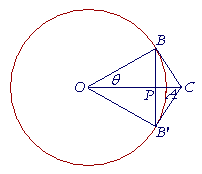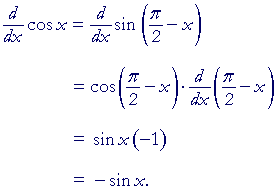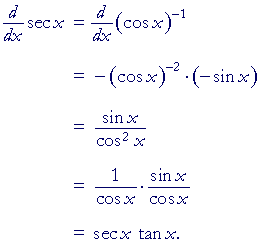12
DERIVATIVES OF
TRIGONOMETRIC FUNCTIONS
THE DERIVATIVE of sin x is equal to cos x. To prove that, we will use the following identity:
sin A − sin B = 2 cos ½(A + B) sin ½(A − B).
(Topic 21 of Trigonometry.)
Problem 1. Use that identity to show:
| sin (x + h) − sin x | = |
To see the proof, pass your mouse over the colored area.
To cover the answer again, click "Refresh" ("Reload").
Do the problem yourself first!
| sin (x + h) − sin x | = | 2 cos ½(x + h + x) sin ½(x + h − x) |
| = | 2 cos ½(2x + h) sin ½h | |
| = |  |
|
Before going on to the derivative of sin x, however, we must prove a lemma; which is a preliminary, susidiary theorem needed to prove a principle theorem. That lemma requires the following identity:
| Problem 2. Show that tan θ divided by sin θ is equal to | 1 cos θ |
: |
| tan θ sin θ |
= | 1 cos θ |
. |
(See Topic 21 of Trigonometry.)
| tan θ sin θ |
= | tan θ· | 1 sin θ |
= | sin θ cos θ |
· | 1 sin θ |
= | 1 cos θ |
The lemma we have to prove is discussed in Topic 15 of Trigonometry. (Take a look at it.) Here it is:
LEMMA. When θ is measured in radians, then
![]()
Proof. It is not possible to prove that by applying the usual theorems on limits (Lesson 2). We have to go to geometry, and to the meanings of sin θ and radian measure.

Let O be the center of a unit circle, that is, a circle of radius 1;
and let θ be the first quadrant central angle AOB, measured in radians.
Then, since arc length s = rθ, and r = 1, arc BA is equal to θ. (Topic 15 of Trigonometry.)
Draw angle B'OA equal to angle θ, thus making arc AB' equal to arc BA;
draw the straight line BB', cutting AO at P;
and draw the straight lines BC, B'C tangent to the circle.
Then
BB' < arc BAB' < BC + CB'.

Now, in that unit circle, BP = PB' = sin θ,
so that BB' = 2 sin θ;
and BC = CB' = tan θ.
The continued inequality above therefore becomes:
2 sin θ < 2θ < 2 tan θ.
On dividing each term by 2 sin θ:
| 1 < | θ sin θ |
< | 1 cos θ |
. |
(Problem 2.) And on taking reciprocals, thus changing the sense:
| 1 > | sin θ θ |
> cos θ. |
(Lesson 11 of Algebra, Theorem 5.)
On changing the signs, the sense changes again :
| −1 < − | sin θ θ |
< | −cos θ, |
(Lesson 11 of Algebra, Theorem 4),
and if we add 1 to each term:
| 0 < | 1 − | sin θ θ |
< | 1 − cos θ. |
Now, as θ becomes very close to 0 (θ ![]() 0), cos θ becomes very close to 1; therefore, 1 − cos θ becomes very close to 0. The expression in the middle, being less than 1 − cos θ, becomes even closer to 0 (and on the left is bounded by 0), therefore the expression in the middle will definitely approach 0. This means:
0), cos θ becomes very close to 1; therefore, 1 − cos θ becomes very close to 0. The expression in the middle, being less than 1 − cos θ, becomes even closer to 0 (and on the left is bounded by 0), therefore the expression in the middle will definitely approach 0. This means:
![]()
Which is what we wanted to prove.
The student should keep in mind that for a variable to "approach" 0 or any limit (Definition 2.1) does not mean that the variable ever equals that limit.
The derivative of sin x
| d dx |
sin x | = cos x |
To prove that, we will apply the definition of the derivative (Lesson 5). First, we will calculate the difference quotient.
| sin (x + h) − sin x h |
= |  |
, Problem 1, |
| = |  |
, on dividing numerator and denominator by 2, |
|
| = |  |
||
We will now take the limit as h ![]() 0. But the limit of a product is equal to the product of the limits. (Lesson 2.) And the factor on the right has the form sin θ/θ. Therefore, according to the Lemma, its limit is 1. Therefore,
0. But the limit of a product is equal to the product of the limits. (Lesson 2.) And the factor on the right has the form sin θ/θ. Therefore, according to the Lemma, its limit is 1. Therefore,
| d dx |
sin x | = cos x. |
We have established the formula.
The derivative of cos x
| d dx |
cos x | = −sin x |
To establish that, we will use the following identity:
| cos x = sin ( | π 2 |
− x). |
A function of any angle is equal to the cofunction of its complement.
(Topic 5 of Trigonometry).
Therefore, on applying the chain rule:

We have established the formula.
The derivative of tan x
| d dx |
tan x = sec²x |
| tan x = | sin x cos x |
. | (Topic 21 of Trigonometry.) |
Therefore according to the quotient rule:
| d dx |
tan x | = | d dx |
sin x cos x |
= | cos x· cos x − sin x(−sin x) cos²x |
||
| = | cos²x + sin²x cos²x |
|||||||
| = | 1 cos²x |
|||||||
| = | sec²x. | |||||||
We have established the formula.
Problem 3. The derivative of cot x. Prove:
| d dx |
cot x = −csc²x |
| d dx |
cot x | = | d dx |
cos x sin x |
= | sin x(−sin x) − cosx· (−cos x) sin²x |
|||
| = | −(sin²x + cos²x) sin²x |
||||||||
| = | − | 1 sin²x |
|||||||
| = | − | csc²x. | |||||||
The derivative of sec x
| d dx |
sec x | = sec x tan x |
| Since sec x = | 1 cos x |
= | (cos x)−1 | , then, on using the chain rule and |
the general power rule:

We have established the formula.
Problem 4. The derivative of csc x. Prove:
| d dx |
csc x | = | −csc x cot x |
| d dx |
csc x | = | d dx |
1 sin x |
= | |||
| = | ||||||||
| = | ||||||||
| = | ||||||||
| = | ||||||||
Example. Calculate the derivative of sin ax².
Solution. On applying the chain rule,
| d dx |
sin ax² | = | cos ax²· | d dx |
ax² | = | cos ax²· | 2ax | = | 2ax cos ax². |
Problem 5. Calculate these derivatives.
| a) | d dx |
sin 5x | = | 5 cos 5x |
| b) | d dx |
½ sin²x | = | sin x cos x |
| c) | d dx |
2 cos 3x | = | −6 sin 3x |
| d) | d dx |
x cos x | = | cos x − x sin x |
| e) | d dx |
sin 2x cos x | = | 2 cos 2x cos x − sin 2x sin x |
| f) | d dx |
tan (3x)² | = | 18x sec (3x)4 |
| g) | d dx |
2 cot | x 2 |
= | − csc² | x 2 |
| h) | d dx |
sec 4x | = | 4 sec 4x tan 4x |
| i) | d dx |
a csc bx | = | −ab csc bx cot bx |
| j) | = |  |
![]()
Next Lesson: Derivatives of inverse trigonometric functions
www.proyectosalonhogar.com
